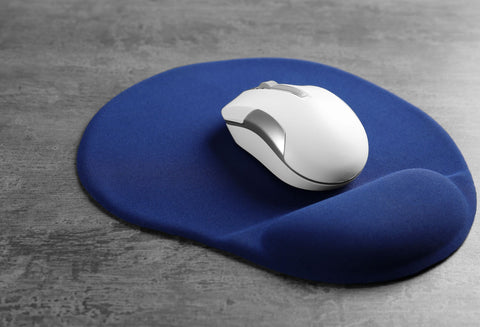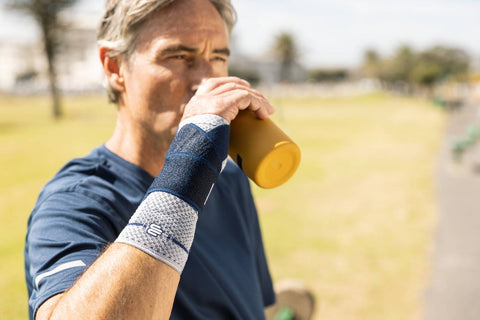Anatomy of Carpal Tunnel Syndrome
Carpal tunnel is a condition affecting the median nerve, which runs through your wrist and into the thumb and middle, index, and ring fingers). Basically, when the tissues surrounding this nerve swell due to overuse, acute injury, or certain medical conditions like diabetes or a thyroid disorder, they press into the nerve’s protective sheath and compress the nerve itself.
With carpal tunnel, you may experience:
- Tingling and numbness
- Pain, especially when you try to hold things or move your hand or fingers
- Feeling like your hand repeatedly falls asleep
- And in some cases, muscle stiffness and loss of mobility
How to relieve carpal tunnel pain
1. Exercise
Shakes
This exercise will loosen your flexor muscles and relieve some pressure on the median nerve.
- Stand up or sit in a chair with your back straight
- Bend your elbows at 90 degrees
- Shake your hands as though you’re trying to get water off them (with your wrist rotating side to side instead of flexing and extending up and down)
Wrist flexion and extension stretches

These will stretch and relieve some tension in your muscles, making it easier to bend your hand up and down without compressing the nerve sheath further.
- Place your arm on a table with your fingers curled into a loose fist.
- For flexion, your palm should be facing up. Bend your affected hand up at the wrist while pressing down on it with your other hand. Hold for 10 seconds, gradually increasing the pressure.
- Release.
- Do 15 reps.
- For extension, your palm should be facing up. Bend your affected hand up at the wrist while pressing down on it with your other hand. Hold for 10 seconds, gradually increasing the pressure.
- Release.
- Do 15 reps.
Median nerve glide
Research shows that nerve gliding exercises are especially effective for relieving carpal tunnel pain. They ease tension in surrounding tissue while relieving pressure on the nerve.
- Position 1: Make a fist with one hand, keeping your thumb curled over the outside. Your palm should be facing inward, toward the opposite side.
- Position 2: Uncurl and straighten your fingers. Straighten your thumb and press it against the side of your hand.
- Position 3: Keeping your fingers and thumb in that same pose, gently bend your hand back toward your forearm as far as is comfortable. You should only feel a slight stretch in your inner wrist.
- Position 4: Keeping the rest of your hand in position 3, stretch your thumb out to the side as far as is comfortable.
- Position 5: rotate your hand so your palm faces directly upward, then straighten your below so your arm is at your side
Hold each position for 5 seconds.
Try to do these exercises at least twice a day, every day until your symptoms subside. We’d also recommend to keep doing them after your carpal tunnel pain resolves, as they can minimise your risk of developing the condition again.
2. Rest
When soft tissues are agitated (especially if that’s due to repetitive stress), it’s best to let them rest. But considering how much we need to use our hands in day-to-day life, it’s not always easy to go long stretches without moving them.
So instead, try to take frequent 5-minute breaks to stop moving your hand. You should also avoid activities that caused the symptoms or that seem to agitate them. That way, you’ll let agitated tissues heal and avoid putting undue stress on the median nerve.
3. Wear a carpal tunnel brace
ManuTrain
A Neurologica study found that both soft braces and wrist splints relieve carpal tunnel pain and improve function in carpal tunnel patients.
Soft braces like our ManuTrain do so through a system of compression knit fabric and a gel pad. These work together to massage the joint, relieving pain. The compression fabric also activates the muscles, helping them act as better supports for your agitated tissues and nerve. You’ll also have a sturdy wrist wrap for increased support.
Rigid wrist braces and wrist splints like the ManuLoc are better suited for more severe cases. The splints, padding, and adjustable straps provide more advanced support for your hand. You’ll still be able to move your fingers and do most activities while you wear it, just with your wrist locked in place.
If your carpel tunnel pain shoots into the thumb, you could instead try the ManuLoc Rhizo. It has an added splinted segment to support the thumb joint.
4. Ice and heat

Ice relieves inflammation and can temporarily numb the aching nerve, relieving carpal tunnel pain. Wrap an ice pack around your wrist and leave it for 15 minutes. You can repeat this process a few times a day. Just make sure to leave a couple of hours between each session.
Do note, though, ice constricts blood vessels and can stiffen muscles. If you use an ice pack too often, you might slow the healing process.
If you feel like your muscles are growing stiff, apply a heat pack or dunk your hands into a sink or bucket filled with warm water. Heat is great for soothing sore and stiff muscles and boosting circulation through the joint.
5. Think ergonomically

You’ll also need to make some changes to your workstation. These may include:
- An ergonomic mouse pad that supports your wrist while you work
- Getting a mouse instead of using the *pad thing on the keyboard, as that will be a lot easier on your wrist and forearm tendons and muscles
- Adjusting your chair height so your elbows are bent at 90 degrees.
6. Pain medication
You can also take over-the-counter pain relief medications like ibuprofen. Remember, however, that you should only take them with other conservative treatment methods. Because while they’re great for relieving pain, they won’t do much to address what’s causing the pain.
To sum up
With tingling, numbness, and outright pain, carpal tunnel syndrome is an unpleasant addition to anyone’s daily routine. Fortunately, relieving pressure on the medial nerve compartment can relieve your pain. That’s why bracing, exercises, and ice and heat packs are some of the best carpal tunnel pain relief methods.
See our collection of wrist injury supports: Wrist Braces Australia





















